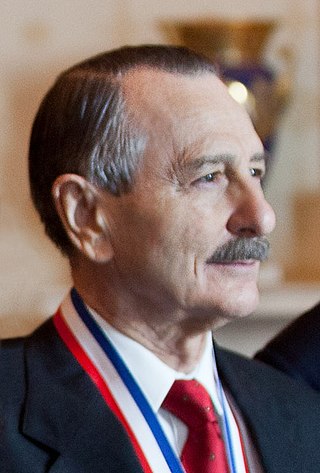Related Research Articles
Superfetation is the simultaneous occurrence of more than one stage of developing offspring in the same animal.

A freemartin or free-martin is an infertile cow with masculinized behavior and non-functioning ovaries. Phenotypically, the animal appears female, but various aspects of female reproductive development are altered due to acquisition of anti-Müllerian hormone from the male twin. Genetically, the animal is chimeric: karyotypy of a sample of cells shows XX/XY chromosomes. The animal originates as a female (XX), but acquires the male (XY) component in utero by exchange of some cellular material from a male twin, via vascular connections between placentas: an example of microchimerism. The chimerism is mainly present in the hematopoietic stem cells.

Bangladesh Agricultural University, abbreviated as BAU, was established in 1961. It is the first agricultural university and also the second largest public university of Bangladesh. This university is located in Mymensingh. The university has 44 departments.

Semen collection refers to the process of obtaining semen from human males or other animals with the use of various methods, for the purposes of artificial insemination, or medical study. Semen can be collected via masturbation, prostate massage, artificial vagina, penile vibratory stimulation (vibroejaculation) and electroejaculation. Semen can be collected from endangered species for cryopreservation of genetic resources.
The estrous cycle is a set of recurring physiological changes induced by reproductive hormones in females of mammalian subclass Theria. Estrous cycles start after sexual maturity in females and are interrupted by anestrous phases, otherwise known as "rest" phases, or by pregnancies. Typically, estrous cycles repeat until death. These cycles are widely variable in duration and frequency depending on the species. Some animals may display bloody vaginal discharge, often mistaken for menstruation. Many mammals used in commercial agriculture, such as cattle and sheep, may have their estrous cycles artificially controlled with hormonal medications for optimum productivity. The male equivalent, seen primarily in ruminants, is called rut.
A veterinary specialist is a veterinarian who specializes in a clinical field of veterinary medicine.
The Faculty of Veterinary Medicine at Université de Montréal is one of five veterinary medical schools in Canada. It is the only French-language veterinary college in North America. The faculty is part of the Université de Montréal and is located in Saint-Hyacinthe, Quebec near Montreal.
Robert Hermes is a veterinarian researcher at The Leibniz-Institute of Zoo and Wildlife Research in Berlin. He studied veterinary medicine at the Freie Universität Berlin. He completed a Ph.D. in reproductive management.

Motilal Madan is an Indian biotechnology researcher, veterinarian, academic and administrator. In a career spanning over 35 years, Madan published 432 research articles and policy papers in international and national reference journals—including 226 original research papers—and pioneered research in reproductive endocrinology, embryo biotechnology, In vitro fertilisation, and cloning.
College of Veterinary Science and Animal Husbandry, Anand is a college for the study of veterinary medicine in Anand, Gujarat, in india.
Reproductive endocrinology and infertility (REI) is a surgical subspecialty of obstetrics and gynecology that trains physicians in reproductive medicine addressing hormonal functioning as it pertains to reproduction as well as the issue of infertility. While most REI specialists primarily focus on the treatment of infertility, reproductive endocrinologists are trained to also test and treat hormonal dysfunctions in females and males outside infertility. Reproductive endocrinologists have specialty training (residency) in obstetrics and gynecology (ob-gyn) before they undergo sub-specialty training (fellowship) in REI.

Veterinary obstetrics are the obstetrical methods used in veterinary medicine, which are quite different from those of human medicine. Veterinary obstetrics is a branch of veterinary medicine that deals with medical and surgical care together with manipulations of the female animals in breeding, gestation, labor, puerperium, and care of the newborn.

Ralph Lawrence Brinster is an American geneticist, National Medal of Science laureate, and Richard King Mellon Professor of Reproductive Physiology at the School of Veterinary Medicine, University of Pennsylvania.

Guru Angad Dev Veterinary and Animal Sciences University is a veterinary university in ludhiana Punjab, india. It was a part of Punjab Agricultural University and was established on 9 August 2005 to serve the society by promoting the livestock production, health and prevention of diseases through integrated teaching and extension programs. The mission of the college is to produce veterinary graduates, scientists and extension workers for promoting better livestock health, by prevention of disease, increasing production and reproduction of livestock, thus improving the quality of rural life in Punjab.
A prosection is the dissection of a cadaver or part of a cadaver by an experienced anatomist in order to demonstrate for students anatomic structure. In a dissection, students learn by doing; in a prosection, students learn by either observing a dissection being performed by an experienced anatomist or examining a specimen that has already been dissected by an experienced anatomist.

Aglepristone is a synthetic, steroidal antiprogestogen related to mifepristone which is marketed by Virbac in several European countries for use in veterinary medicine. It is specifically used as an abortifacient in pregnant animals. Aglepristone, similarly to mifepristone, also possesses some antiglucocorticoid activity.
Stephen J. Roberts (1915–2005), also known as "Doc Roberts", was an American veterinarian, Professor at Cornell University, polo player and coach.

JoGayle Dillon Howard was an American zoologist and theriogenologist specializing in the captive breeding of endangered species such as pandas, clouded leopards, and black-footed ferrets.
Justine K. O'Brien, an Australian zoologist, is best known for her use of reproductive research to assist in wildlife management and conservation.
M. Golam Shahi Alam is a Bangladeshi academic, currently working as one of the members of Bangladesh Accreditation Council. He is the former vice-chancellor of Sylhet Agricultural University. Prior to this, Shahi Alam was a professor of Surgery and Obstetrics department under Veterinary faculty of Bangladesh Agriculture University, Mymensingh.
References
- ↑ Howe, Herbert. "History and Term of Theriogenology". Society for Theriogenology.